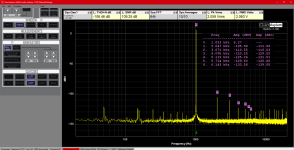Hi guys, it's been some time, but I have some measurements (with Quant Asylum QA403) and I'll be probing with a scope (Siglent SDS-1104X-E soon).
DC offset is below the capabilities of my voltmeter, it shows <1mV.
For my first discrete design, I'd say it's pretty decent 🙂 Happy to hear your thoughts!
DC offset is below the capabilities of my voltmeter, it shows <1mV.
For my first discrete design, I'd say it's pretty decent 🙂 Happy to hear your thoughts!
Attachments
Last edited:
Works fantastic on power amplifiers, or anything capable of generating significant power/voltage. Used it to find UHF oscillation in a tube amp that was totally invisible on my DSO. Unfortunately, oscillations (or just square wave overshoot) may be too low to detect on a solid state preamp this way. OP’s circuit was all small signal transistors and had 47 ohm emitter resistors. If you have a 20 millivolt oscillation it won’t even turn on the diode. Something capable of toasting tweeters or blowing a set of output transistors, or even just making it sound awful, yes.@indianajo 's response is interesting. When you have a small coupling capacitor and some fast, basic rectifier circuit, you can make oscillations anywhere up to hundreds of megahertz visible with a meter that doesn't have such a large bandwidth.
old Simpson meters appear to have a bridge of selenium rectifiers. No 0.6 v diode drop. Or even 0.3 v for schottky.If you have a 20 millivolt oscillation it won’t even turn on the diode.
